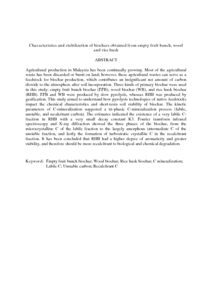Citation
Abdulrazzaq, Huda and Jol, Hamdan and Mohd Hanif, Ahmad Husni and Abu Bakar, Rosenani
(2014)
Characteristics and stabilization of biochars obtained from empty fruit bunch, wood and rice husk.
BioResources, 9 (2).
pp. 2888-2898.
ISSN 1930-2126
Abstract
Agricultural production in Malaysia has been continually growing. Most of the agricultural waste has been discarded or burnt on land; however, these agricultural wastes can serve as a feedstock for biochar production, which contributes an insignificant net amount of carbon dioxide to the atmosphere after soil incorporation. Three kinds of primary biochar were used in this study: empty fruit bunch biochar (EFB), wood biochar (WB), and rice husk biochar (RHB). EFB and WB were produced by slow pyrolysis, whereas RHB was produced by gasification. This study aimed to understand how pyrolysis technologies of native feedstocks impact the chemical characteristics and short-term soil stability of biochar. The kinetic parameters of C-mineralization suggested a tri-phasic C-mineralization process (labile, unstable, and recalcitrant carbon). The estimates indicated the existence of a very labile C-fraction in RHB with a very small decay constant K3. Fourier transform infrared spectroscopy and X-ray diffraction showed the three phases of the biochar, from the microcrystalline C of the labile fraction to the largely amorphous intermediate C of the unstable fraction, and lastly the formation of turbostratic crystallite C in the recalcitrant fraction. It has been concluded that RHB had a higher degree of aromaticity and greater stability, and therefore should be more recalcitrant to biological and chemical degradation.
Download File
![[img]](http://psasir.upm.edu.my/36741/1.hassmallThumbnailVersion/Characteristics%20and%20stabilization%20of%20biochars%20obtained%20from%20empty%20fruit%20bunch.pdf)  Preview |
|
PDF (Abstract)
Characteristics and stabilization of biochars obtained from empty fruit bunch.pdf
Download (85kB)
| Preview
|
|
Additional Metadata
Actions (login required)
 |
View Item |

